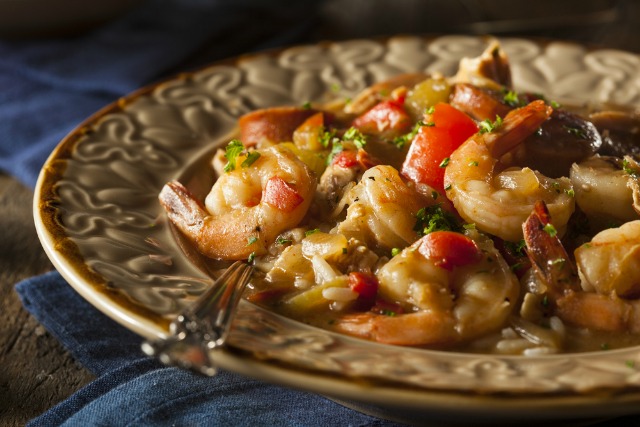How To Make A Really Great Gumbo For National Gumbo Day
By Staff in Food on Oct 12, 2015 6:50PM

Our homemade gumbo to celebrate this fine holiday. Photo by Heather Lalley.
By Heather Lalley
Happy National Gumbo Day! Did you get us a card? Better yet, did you get us a piping-hot bowl of this most-perfect combination of intensely flavored stock, meat, shrimp and vegetables?
Not yet? Well, it’s time to get in the kitchen. We consulted with a couple of gumbo mavens (and made our own pot, too) to bring you all the tips and tricks you need for gumbo success.
So, what’s gumbo anyway? It’s a hearty stew first made popular in southern Louisiana a couple hundred years ago (but it stretches back even farther than that, to traditional West African cooking). There are several different kinds, but all contain a flavorful stock, some kind of thickener, meat and/or shellfish and the all-important combo of celery, bell peppers and onions (the holy trinity of Cajun cooking).
Gumbos can be thickened with a roux (a slow-cooked mixture of fat and flour), filé powder (made from ground sassafras leaves) or okra. (Chef Paul Prudhomme, who died last week, popularized roux-based gumbos around New Orleans and the rest of the country.)

Gumbo, via Shutterstock
Before cooking anything, though, have all ingredients ready. “Once you start, you’re committed to the pot for a while,” says Chef Alfredo Nogueria of Analogue in Chicago's Logan Square. It can take 20 to 40 minutes or so to get the roux the right color, Nogueria says. He uses rendered chicken fat and flour and takes his roux to the color of “rich mahogany oxblood.”
Chef Paul Fehribach of Andersonville’s Big Jones likes to start his gumbo in a heavy-bottomed Dutch oven. He advises home cooks to take the roux “low and slow” to avoid burning. “You don’t want black specks in the roux,” Fehribach says. “You can’t save a burnt roux.” His Big Jones Cookbook has a great gumbo recipe: Check it out.
Both chefs recommend adding the chopped vegetables as soon as the roux reaches the desired color. The coolness of the vegetables will slow the roux’s cooking. Stock should be added slowly, to avoid lumps, and carefully, to avoid creating a watery stew.
“The darker you go with the roux, the less thickening properties it has,” Nogueria says. “You can always add more in.”
It’s easy to make your own stock, using scraps from the protein used in the dish. We made a simple seafood stock with shrimp shells and clam juice. Restaurants often make their own Andouille sausage for gumbo. Home cooks in Chicago should seek out a good-quality Polish kielbasa.
If you're looking for a great recipe, here's a good place to start. We tested this recipe over the weekend with delicious results. Happy gumbo day!
Creole-Style Shrimp and Sausage Gumbo
Serves 6 to 8
From “The Cook’s Illustrated Cookbook”
1 ½ pounds small shrimp (51 to 60 per pound), peeled and deveined; shells reserved
3 ½ cups ice water
1 (8-ounce) bottle clam juice
½ cup vegetable oil
½ cup all-purpose flour
2 onions, chopped fine
1 red bell pepper, stemmed, seeded and chopped fine
1 celery rib, chopped fine
6 garlic cloves, minced
1 teaspoon dried thyme
Salt and pepper
Cayenne pepper
2 bay leaves
1 pound smoked sausage (we used a nice-quality, Chicago-made Polish kielbsasa), sliced ¼-inch thick
½ cup minced fresh parsley
4 scallions, sliced thin
Be sure to have all ingredients prepped before beginning the roux.
Bring reserved shrimp shells and 4 ½ cups water to boil in a large saucepan over medium-high heat. Reduce to medium-low and simmer for 20 minutes. Strain stock and add ice water and clam juice. (You’ll have about 8 cups of tepid stock.) Set aside.
Heat oil in Dutch oven over medium-high heat for 2 minutes. Reduce heat to medium and slowly stir in flour with long-handled spatula or spoon. (A flat, sauce whisk is useful here.) Make sure to work out any lumps. Keep stirring constantly, reaching all areas of the pan, for about 20 minutes. The roux should become deep reddish brown and have a toasty aroma. (If it begins to smoke, remove from heat and cool slightly before continuing.)
Add onions, bell pepper, celery, garlic, thyme, 1 teaspoon sat and ¼ teaspoon cayenne to the roux and cook, stirring frequently, until vegetables soften, about 8 to 10 minutes.
Add 4 cups of reserved stock in a slow, steady stream while stirring vigorously. Stir in remaining 4 cups of stock (or use as much as is necessary to reach desired consistency; you might have stock left over). Increase heat to high, bring to a boil. Reduce heat to medium-low, skim foam from surface. Add bay leaves and simmer, uncovered, for about 30 minutes., skimming foam as it arises. (This mixture can be covered and set aside for several hours or refrigerated for up to 2 days.)
Stir in sausage and continue simmering, about 30 minutes. Stir in shrimp and simmer until cooked through, about 5 minutes. Off heat, stir in parsley and scallions and season with salt, pepper and cayenne to taste. Discard bay leaves and serve immediately.
NOTE: If you like, add 10 ounces of thawed frozen cut okra to the roux with the other vegetables.
Heather Lalley is a Chicago-based journalist and author of "The Chicago Homegrown Cookbook." She never met a fried potato she didn't adore. Find her on Twitter @flourgrrrl.